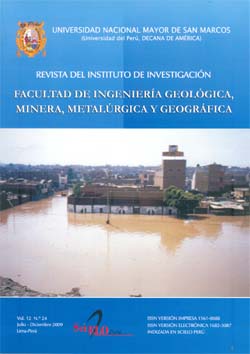Phosphates in the zone of ocucaje - south of Ica- Perú
DOI:
https://doi.org/10.15381/iigeo.v12i24.353Keywords:
Ocucaje Phosphates, Phosphates in southern Peru, phosphatic nodules, phosphate rockAbstract
This work consist to explore, locate and quantify variety of phosphorus mineral apatite Cl FCa3 (PO4)3, in nodules formed by sandstones are gray outdoor spread or scattered over the surfaces of terraces, plains and slopes located on the right bank of the river ICA, partially or totally covered by sand, silt, clay from wind, central shoal area that includes the hill Whale, an area west of the town of Ocucaje. The nodules described come from three sandy layers or horizons, different, consistent, failed and separated from each other 40m, outcrop in the cliffs of the escarpment or shoals; Whale, Central, white hills, Witch and Holy Well, located on the right bank of river ICA, section Ocucaje, located 35km. southwest of the city ICA. The calcium phosphate apatite is fluorine and chlorine in varying amounts, 7% of P2 O5 , in nodules are white sandstone gray or black, uneven tone, vitreous to greasy luster, Mohs hardness scale 5, conchoidal fracture, specific gravity 3.1 – 3.2, exceptional luminescence. This phosphate is mined in large quantities, in phosphate rocks (Rusia – EE.UU.) and phosphatic sands in Morocco is the world’s largest producer.Downloads
Published
Issue
Section
License
Copyright (c) 2009 Tomas Gallarday B

This work is licensed under a Creative Commons Attribution-NonCommercial-ShareAlike 4.0 International License.
AUTHORS RETAIN THEIR RIGHTS:
a. Authors retain their trade mark rights and patent, and also on any process or procedure described in the article.
b. Authors retain their right to share, copy, distribute, perform and publicly communicate their article (eg, to place their article in an institutional repository or publish it in a book), with an acknowledgment of its initial publication in the Rev. Inst. investig. Fac. minas metal cienc. geogr.
c. Authors retain theirs right to make a subsequent publication of their work, to use the article or any part thereof (eg a compilation of his papers, lecture notes, thesis, or a book), always indicating the source of publication (the originator of the work, journal, volume, number and date).






